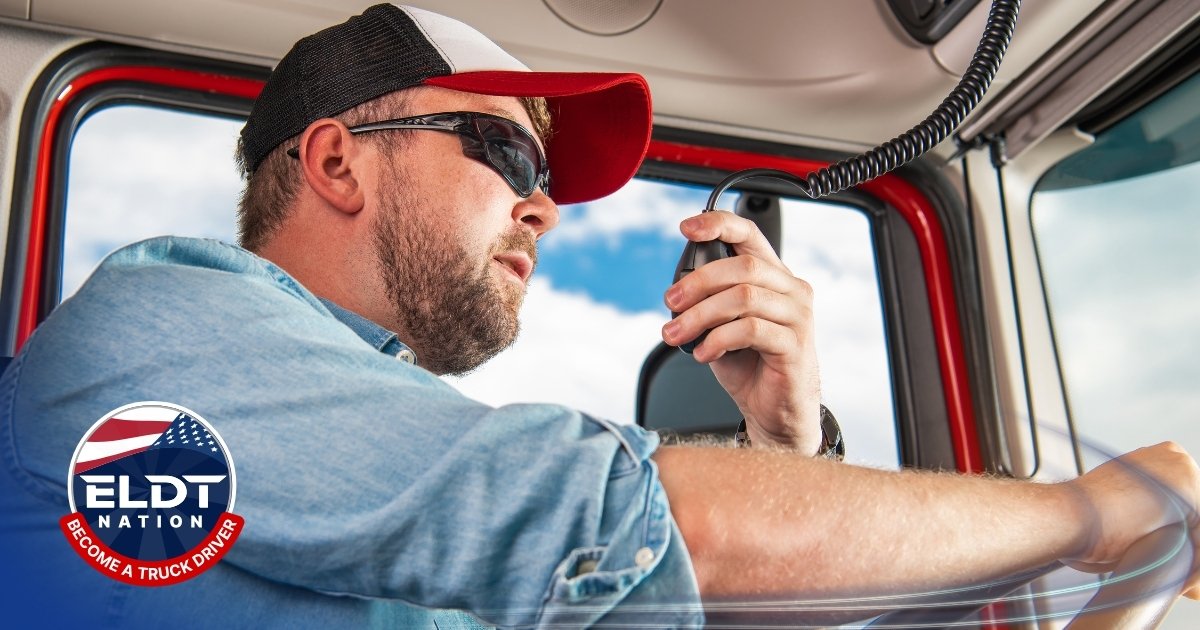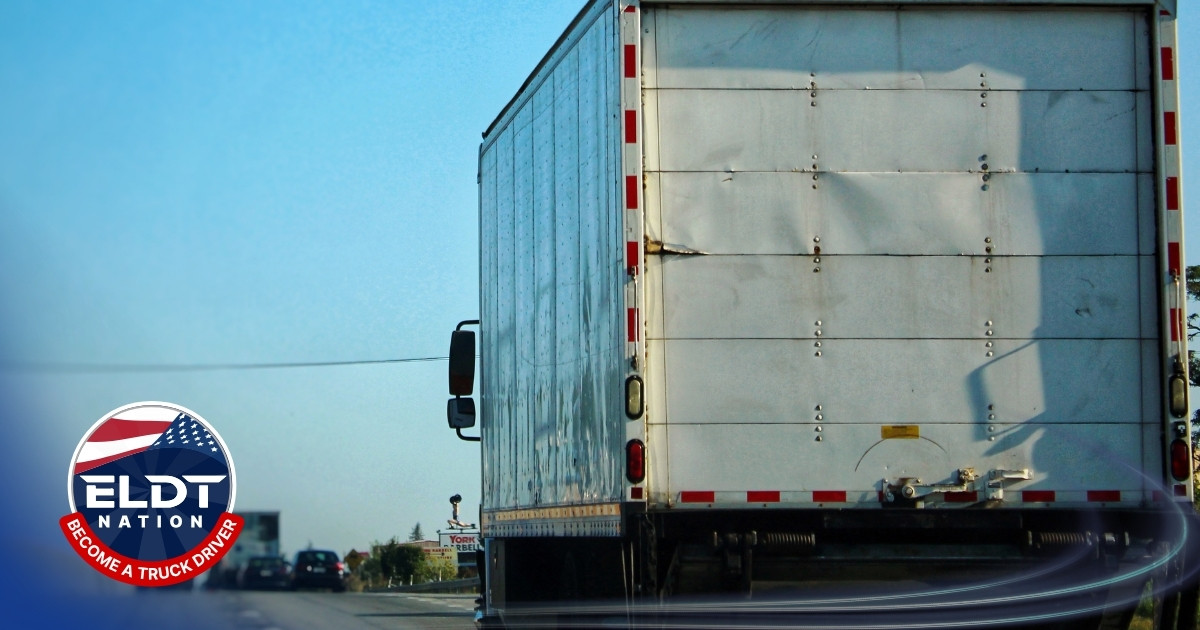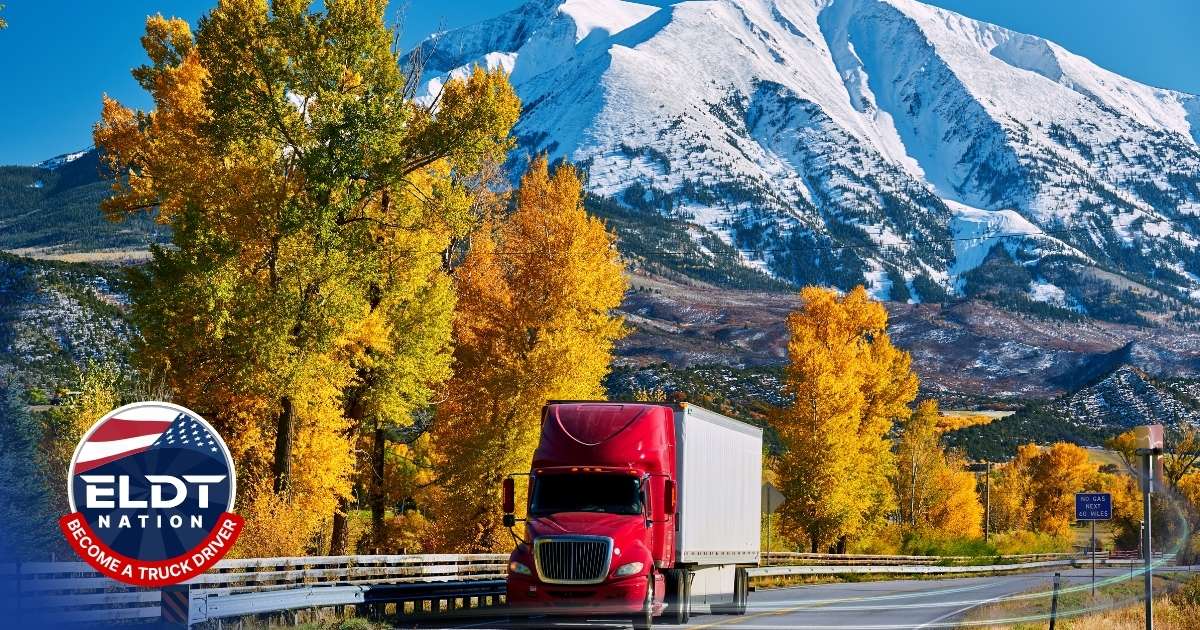How to Become an Owner Operator in Trucking | A Complete Guide
Thinking about leaving your company driver job to become an owner-operator? Let's be clear: this isn't just a job change. It's a leap into entrepreneurship. You're trading in your employee hat for the CEO chair of your own trucking business. Every decision, from finding freight to managing the books, now rests on your shoulders.
Your Roadmap from Company Truck Driver to Business Owner
Making the jump from company driver to owner-operator is probably the biggest move you can make in your trucking career. It’s not just about owning the rig; it’s about owning the entire operation. The promise of bigger paychecks and the freedom to pick your own loads is what pulls most drivers in.
But to get there, you have to completely shift your mindset. You're not just a driver anymore. You're the boss, the accountant, and the head of operations, all rolled into one. This guide will give you a real, no-fluff roadmap for that journey.
Shifting from Employee to Entrepreneur
The biggest change is wrapping your head around all your new responsibilities. As a company driver, your main job is getting from Point A to Point B safely and on time. As an owner-operator, that's just the beginning.
Your new day-to-day includes:
- Managing the Money: You'll handle everything. Truck payments, insurance, fuel, maintenance, and figuring out your taxes.
- Finding the Work: It's on you to chase down good-paying freight, negotiate rates, and build solid relationships with brokers and shippers.
- Staying Legal: All the paperwork—your operating authority, IFTA filings, and everything in between—has to be perfect and on time. No excuses.
- Keeping the Truck Running: You're in charge of all maintenance and repairs. Your truck is your biggest investment, and keeping it on the road is priority number one.
This is a huge step, but you're walking into a massive and vital industry. The global freight trucking market is worth around $2.2 trillion, and owner-operators are a huge piece of that puzzle, making up about 11.1% of all drivers. As you can see from these industry insights about owner-operator trends, you're not just a small player—you're essential.
Before we dive deeper, let's break down the core differences between the two roles. It’s important to see exactly what you’re signing up for.
Owner Operator vs Company Truck Driver Key Differences
Seeing it laid out like that makes it pretty clear. The freedom and financial upside for an owner-operator are massive, but so are the risks and responsibilities.
Key Takeaway: Becoming an owner-operator means you stop working for a company and start running your own. Success hinges just as much on your business smarts as it does on your driving skills.
Laying the Groundwork for Your Trucking Business: Experience and Authority

Before you even start pricing out rigs, you need to build a solid foundation. The most successful owner-operators I know didn't just jump in cold. They started by getting real-world experience and then methodically handled the legal side of things.
My advice? Get at least two years of solid seat time as a company driver before you even think about buying your own truck. This time is priceless. You’ll learn the true rhythm of the road, figure out different types of freight, and see how a real trucking company handles dispatch, delays, and breakdowns—all on their dime, not yours.
Making It Official: Your CDL and Operating Authority
Once you’ve got the road experience, it’s time to get your business on the books. This is the part where you stop being just a driver and become a legal business entity. The first hurdle, if you haven’t cleared it already, is your Commercial Driver's License.
Your Commercial Driver’s License (CDL) is non-negotiable; it's the baseline requirement for operating a heavy commercial vehicle. But that’s just the start. To operate as an independent trucking business, you'll also need to get your USDOT number and a Motor Carrier (MC) number. These aren't just suggestions—they are federal requirements from the Federal Motor Carrier Safety Administration (FMCSA).
Pro Tip: Don't treat this like just a pile of paperwork. Your USDOT and MC numbers are your business's legal DNA. Any mistakes or slip-ups here can stop your operation dead in its tracks.
Your Legal To-Do List
Getting compliant isn’t just filling out a single form. It’s a series of steps to make sure you’re operating safely and legally. While states can have minor differences, here’s the core checklist every new owner-operator has to tackle:
- Commercial Driver's License (CDL): The essential license to drive a rig. If you're starting from square one, our guide on how to become a truck driver will get you going.
- USDOT Number: This is your unique ID with the FMCSA. It’s used for tracking safety records and compliance.
- Motor Carrier (MC) Number: This is your operating authority. It’s what lets you legally haul freight for-hire across state lines.
- BOC-3 Filing: You have to designate a process agent in each state where you'll run. This person is authorized to receive legal documents for your business.
Getting all these pieces in place is a critical part of the process. Take your time, double-check every detail, and make sure your legal house is in order before your wheels hit the pavement under your own authority.
Building Your Business and Financial Plan
This is where the rubber meets the road—or, in this case, where your dream of being an owner-operator meets a spreadsheet. A fuzzy idea like "I want to make more money" won't cut it. You need a rock-solid business plan that treats your new venture like the serious startup it is.
Lenders won’t even look at you without one. More importantly, you can't steer your business toward success without a map. And that map needs to account for every single dollar it takes to get rolling and keep those wheels turning.
Calculating Your Real Startup Costs
Before you earn your first dime, you’re going to spend a good chunk of change. Most aspiring owner-operators seriously underestimate this part. Your budget has to cover a lot more than just the down payment on a rig.
Here’s a realistic look at some of the initial cash you'll need to have on hand:
- Insurance Down Payment: This is often a big one. Be prepared to pay 20-25% of your entire annual premium right upfront.
- Registrations and Permits: The costs for your IRP (International Registration Plan) plates, IFTA decals, and other state-specific permits add up fast.
- Legal & Formation Fees: Setting up your LLC or S-Corp isn't free. You'll have filing fees and might want to pay for some professional advice to get it right.
- Operating Cash Reserve: This is your safety net. You absolutely need at least one or two months of fixed expenses sitting in the bank to cover you before those first invoices get paid.
One of the most common mistakes new owner-operators make is underestimating their cash flow needs. Plan on having enough cash to cover all your truck and personal expenses for at least 60 days. This buffer is critical for surviving the slow payment cycles at the beginning.
Projecting Your Revenue and Expenses
Once you know your startup costs, you have to figure out your ongoing operational finances. This is the heart and soul of your business plan. The goal here is to get a crystal-clear picture of your cost per mile (CPM) so you know instantly which freight rates are actually profitable.
Fixed Costs are the bills you pay whether the truck is moving or parked:
- Truck and trailer payments
- Insurance premiums
- Permit renewals
- Health insurance
Variable Costs change depending on how many miles you’re running:
- Fuel (this will be your biggest variable expense, by far)
- Tires
- Routine maintenance and repairs
- Broker fees and load board subscriptions
Forecasting your income is just as critical. Do your homework and research the current market rates for the lanes you want to run. It's tempting to plug in optimistic numbers, but it's much smarter to be conservative. To get a realistic sense of what you can earn, check out data on the average salaries and revenue for truckers. This will help ground your projections in reality, not just wishful thinking.
When you walk into a lender's office—whether it's a traditional bank or a specialized commercial lender—they will pick these projections apart. They need to see that you’ve done the research and truly understand the financial reality of this business. A detailed, well-researched plan shows them you’re a serious professional, not a risky bet.
Buying Your Rig and Securing Essential Insurance
Alright, you’ve got your business plan and financing lined up. Now for the exciting part—and the single biggest purchase you’ll make: your truck. This machine is the absolute heart of your operation, so the choice between new and used will echo through your finances for years to come.
There’s no one-size-fits-all answer here. It really boils down to your starting capital, how much risk you can stomach, and your long-term game plan.
A shiny new rig offers a factory warranty, the latest fuel-saving tech, and the comfort of knowing you're its first and only driver. But that sticker price is steep, and a massive monthly payment can be a lead weight on your business in that crucial first year. On the flip side, a used truck is much easier on the wallet upfront but comes with the very real risk of inheriting another driver's headaches.
Choosing Your First Truck
When you’re just getting started, a reliable used truck is almost always the smarter financial play. The trick is to avoid a lemon that will bleed your maintenance budget dry before you even get rolling. A thorough, hands-on inspection isn't just a good idea—it's non-negotiable.
Here’s a practical checklist I'd use when kicking the tires on a used rig:
- Engine History: Get your hands on those maintenance records. You want to see proof of regular oil changes and any major work, like an overhaul.
- Tire Condition: Check the tread depth, of course, but also look for uneven wear patterns. That’s a classic sign of alignment or suspension problems, and a new set of tires can easily set you back thousands.
- Cab and Frame Inspection: Get underneath and look for rust, paying close attention to the frame rails. Inside the cab, check for any water leaks or signs of past damage.
- Test Drive: This is where you listen. Pay attention to any weird noises from the engine or transmission. Feel how it handles—does it pull to one side? Does it feel solid?
I’ve seen new owner-operators go belly-up because they bought a cheap truck that spent more time in the shop than it did on the road. A slightly pricier, well-maintained used truck is a far better investment than a bargain rig with a sketchy past.
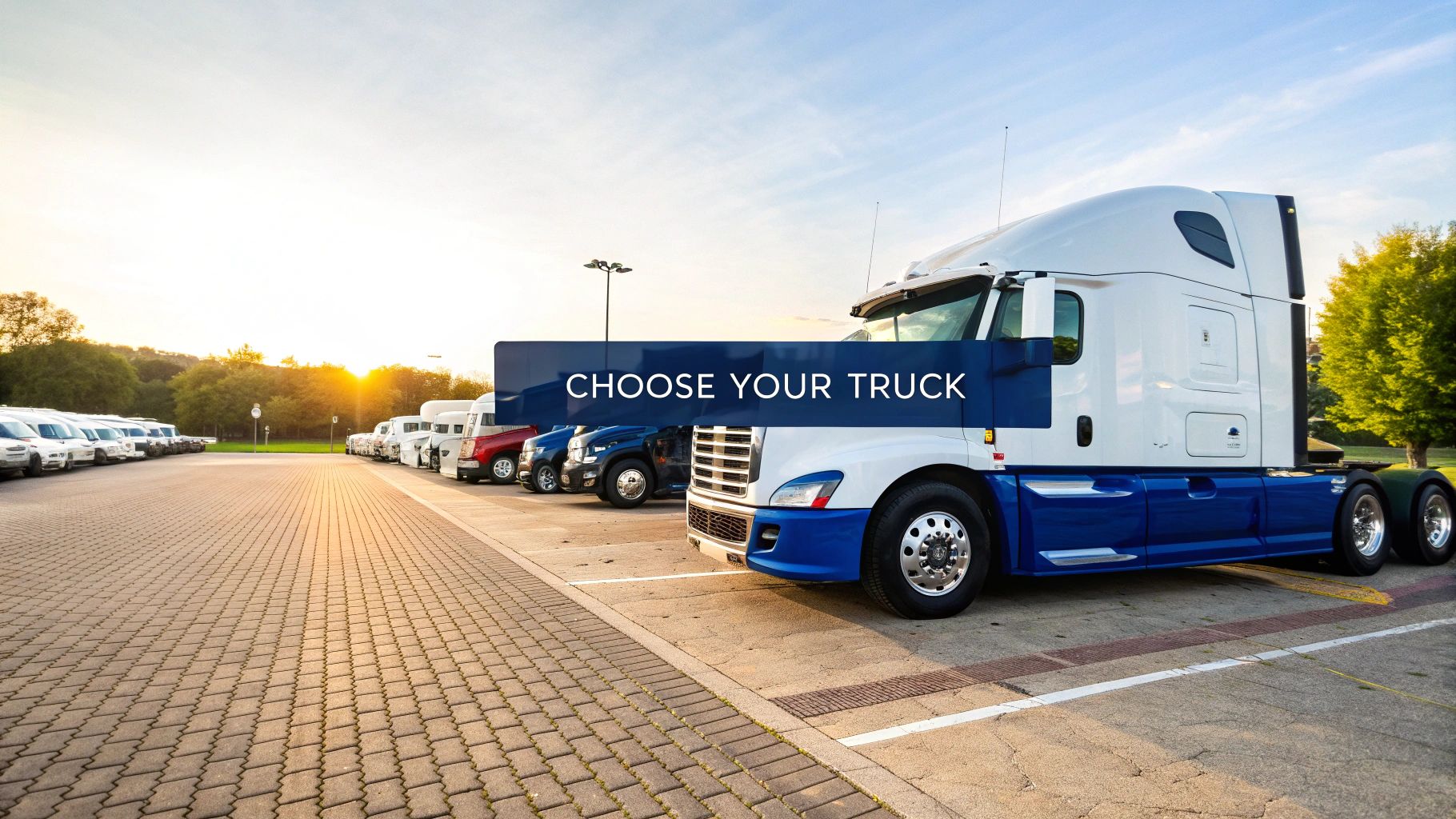
Getting the Right Insurance Coverage
Once you have your truck, your very next call should be to an insurance agent. This is one area where trying to save a few bucks can be a catastrophic mistake. Your insurance is the only thing standing between a single bad day and losing everything you've built.
As an independent owner-operator, you need a policy that truly has you covered. Even if the carrier you lease on with offers some insurance, it's rarely enough. You'll almost always need supplemental policies to be fully protected.
These are the core coverages you absolutely cannot operate without:
- Primary Liability: This is the big one, and it’s federally required. It covers damage to other people and their property if you’re at fault in an accident.
- Motor Truck Cargo: This protects the value of the freight you’re hauling if it gets damaged, lost, or stolen.
- Physical Damage: This is what pays to fix or replace your truck and trailer after an incident.
Don't just chase the lowest price. You need to talk to an agent who lives and breathes commercial trucking insurance. They know the industry and can walk you through the fine print to make sure you’re not left exposed when you need that coverage the most.
Finding Profitable Loads and Managing Operations
Alright, you’ve got the truck, the authority, and all the legal paperwork is buttoned up. That’s a huge milestone, but the real work starts now. The daily grind of being a business owner means keeping that truck rolling with freight that actually pays the bills.
Your success from here on out hinges on two things: finding profitable loads consistently and managing your business like a pro. Most new owner-operators start by living on load boards, but the smartest ones quickly learn to diversify.
Strategies for Sourcing Quality Freight
Think of finding freight as having a few different tools in your toolbox. You’ll probably use all of them at different times, especially when you're just getting your wheels under you.
The most common starting point is load boards. These are the digital marketplaces where freight brokers and shippers post loads they need to move. While you can find some free options, the best, highest-paying loads are almost always on paid subscription boards. Treat it as a non-negotiable business expense.
Once you start hauling, you’ll naturally build relationships with freight brokers. A good broker is an incredible asset. They get to know your truck, your preferred lanes, and your reliability. A broker who trusts you will start calling you directly with quality freight before it ever gets posted publicly.
The real long-term goal? Direct shipper contracts. This is where you work directly with the company whose freight you’re hauling, cutting out the broker entirely. That means you keep a much bigger piece of the pie. Landing these contracts takes time and a rock-solid reputation for being on time, every time.
Comparing Methods for Finding Freight
Let's break down the most common ways to find loads. Each has its place, and understanding the pros and cons will help you build a solid strategy for keeping your trailer full.
Ultimately, a mix of these methods is the smartest approach. Use load boards to stay moving, nurture broker relationships for steady work, and always keep an eye out for opportunities to connect directly with shippers.
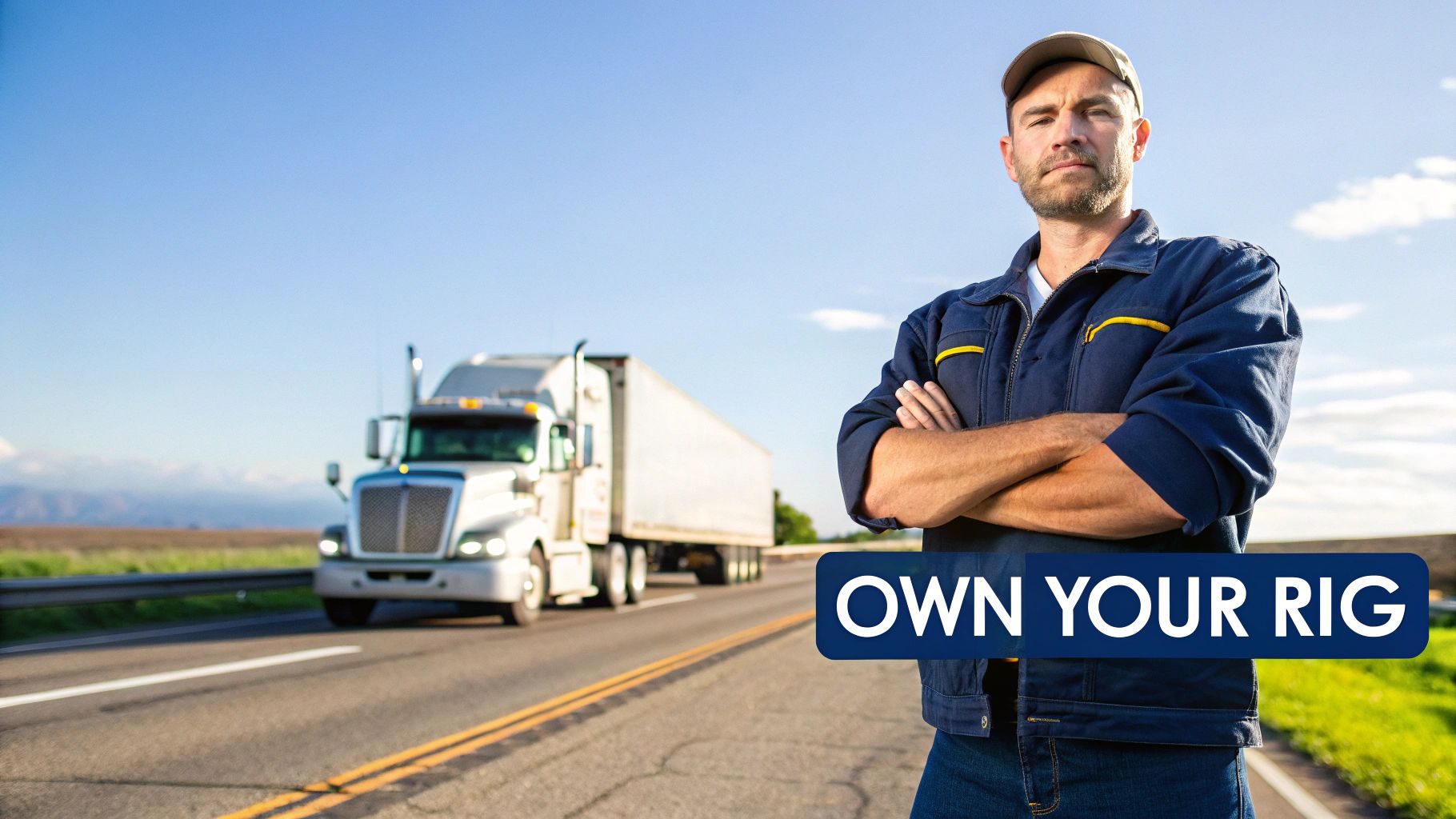
Mastering Negotiations and Day-to-Day Management
Finding a load is just step one. Turning it into a profitable load is what matters. Don't ever be afraid to negotiate. The rate you see posted on a board is almost always a starting point, not the final offer. You absolutely must know your cost-per-mile (CPM) down to the penny. If a load doesn't cover your costs and leave a healthy profit, walk away.
This is the part where many new owner-operators stumble—the back-office work. It's not glamorous, but it's what separates a successful business from a hobby.
- Cash Flow Management: You have to know where every single dollar is. Use accounting software (like QuickBooks) or even a detailed spreadsheet to track income, fixed costs (truck payment, insurance), and variable costs (fuel, maintenance).
- Expense Tracking: Keep every single receipt. Fuel, tires, oil changes, tolls, even cleaning supplies. This isn't just for your budget; it’s critical for minimizing what you owe in taxes at the end of the year.
- Proactive Maintenance: Don't wait for your truck to tell you something is wrong. Follow a strict preventive maintenance schedule. Every hour your truck is down for a surprise repair is an hour you’re not earning money.
Effectively managing your operations is just as critical as your skill behind the wheel. The discipline it took to earn your license is the same discipline you need to run your business. If you're just getting started on your journey, you can learn more about how to get a CDL right here. Building a reputation for reliability—with brokers, shippers, and yourself—is the absolute key to long-term profitability.
Sustaining and Scaling Your Trucking Business
Making it through your first year as an owner-operator is all about survival. You learn the ropes, figure out cash flow, and keep the wheels turning. But after that? It’s time to stop just surviving and start building a real, lasting business. This is the shift from just being a driver who owns a truck to becoming a true entrepreneur.
A huge piece of this next phase is building up your business credit. Think back to how important your personal credit score was for getting your first truck loan. Your business credit profile works the same way, but it opens doors to much bigger opportunities for future equipment and better financing terms. Every on-time truck payment and insurance premium builds that history lenders love to see.
Knowing When to Expand
The urge to grow is strong. You see the potential, you taste the success, and you want more. But jumping the gun and expanding too soon is a classic mistake that has taken down plenty of otherwise solid trucking businesses.
So, how do you know it's the right time to add a second truck or hire your first driver? The answer isn't a gut feeling; it's in your numbers and your daily workload.
Are you constantly turning down good, profitable loads because you just don't have the capacity? Have you built such a great reputation with brokers or shippers that they’re flat-out asking if you can handle more of their freight? These are the real-world signs that demand is outstripping your supply.
Don’t make a major decision based on a few great weeks. You need to see a steady trend of having too much work for at least six months. That proves the demand is real and not just a hot spot in the market.
Before you even think about calling a dealer, go back to your business plan. You have to map out the full financial hit of a second truck. We're talking the truck payment, insurance, fuel, maintenance, and a driver's salary. A profitable one-truck business doesn't automatically become a profitable two-truck fleet without meticulous planning.
Reinvesting for Long-Term Success
Smart growth isn’t always about adding more trucks. Sometimes, it's about making your current operation smarter, leaner, and more profitable. That means reinvesting your profits wisely. Instead of pulling every extra dollar out for personal use, put some of that cash back into the business to build a stronger foundation.
What does that look like? It could be investing in tech that makes your life easier. A solid Transportation Management System (TMS) can be a game-changer, helping you manage everything from dispatch and invoicing to IFTA reporting and expense tracking in one place. The hours you save on paperwork are hours you can spend finding better freight.
Ultimately, scaling your business means building a brand that high-value clients want to partner with. Every on-time delivery, every clean inspection, and every professional email builds your reputation. That reputation will eventually become your most valuable asset, transforming your business from one that chases loads on a board to one where quality freight comes looking for you.

Ready to take the first step toward your CDL and a career on the open road? ELDT Nation provides FMCSA-approved online training that fits your schedule, helping you pass the theory portion of your exam faster. Start your journey with ELDT Nation today!

